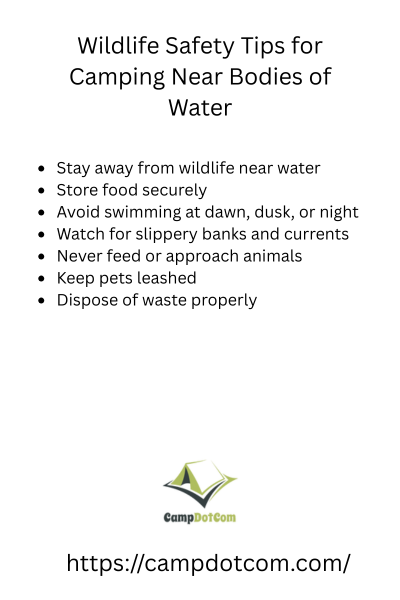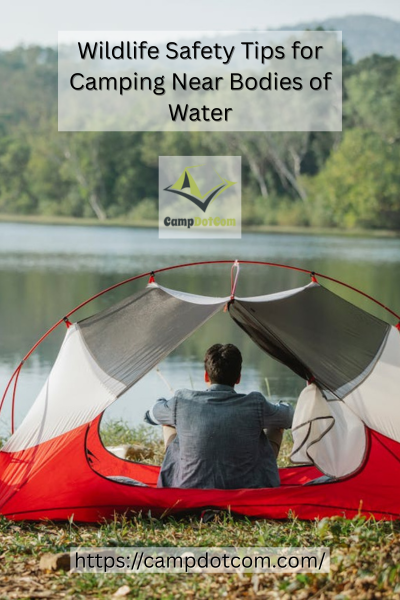If you’re planning a weekend in the wild, these Wildlife Safety Tips for Camping Near Bodies of Water can make all the difference between a peaceful retreat and an unwanted animal encounter.
Let me tell you—I’ve learned a few lessons the hard way. Like the time I thought it’d be “so relaxing” to set up camp right next to a quiet little lake in the middle of nowhere. Gorgeous view, yes. But by 2 a.m., I was staring into the curious eyes of a raccoon that had raided our cooler like it owned the place. Lesson learned.
Read More About Wildlife Safety Tips for Camping Near Bodies of Water

Water Sources Attract All Kinds of Wildlife
Many campers don’t realize at first that bodies of water attract all kinds of wildlife. Deer, bears, snakes, raccoons, and even insects are drawn to them. After all, water provides hydration, food, and shelter. So if you set up camp near a river, lake, or even a slow moving creek, you are essentially sharing space in their natural home.
As an Amazon Associate, I earn from qualifying purchases. Some of the links in this article are affiliate links. This means that, at zero cost to you, I will earn an affiliate commission if you click through the link and finalize a purchase.
That does not mean you should avoid camping near water. It can be beautiful, peaceful, and very convenient. You just need to be aware and take the right precautions, which is where these Wildlife Safety Tips for Camping Near Bodies of Water will help.
More Things to Know About Wildlife Safety Tips for Camping Near Bodies of Water

Choose Your Campsite Carefully
First things first: distance matters. Set up at least 200 feet away from the water’s edge. It might seem like a hike when you’re lugging gear, but you’ll thank yourself later. Animals usually travel along water routes, and you don’t want to be in their way.
I once saw a whole family of deer wander right through someone’s site at dawn because they’d pitched camp practically on the riverbank. Beautiful? Yes. Safe? Nope.
Store Your Food Like a Pro
If there’s one tip you remember from this post, let it be this: keep your food locked up and far from your tent. Even the smell of a granola bar can attract trouble.
Use bear-proof containers or hang your food in a dry bag at least 10 feet off the ground and 100 feet away from your sleeping area. That includes trash, too—especially wrappers or anything with a scent. I mean, raccoons have zero shame and all the skill when it comes to breaking into bags.
Learn the Signs Around You
Want to know who else might be hanging out near your site? Look for clues. Tracks, droppings, claw marks on trees, or disturbed brush can all hint at local wildlife activity. It’s not about scaring yourself—it’s about being aware.
One morning on a trip to the Smokies, I noticed fresh bear prints on the muddy trail by the stream. We ended up shifting camp uphill, away from the water. Didn’t see the bear again, but we slept better knowing we’d made the right call.
Don’t Feed the Wildlife (Seriously)
It can be tempting, especially when you see something cute like a squirrel or a duck, but feeding wildlife, even the ones that seem harmless, can lead to long term problems. Animals begin to associate people with food, and that creates risky situations for everyone, including the animal.
I once saw someone toss crackers to a raccoon from his kayak. That same raccoon tried to climb into our food container later that night. Coincidence? I do not think so.
Watch Out for Slithery Friends
Snakes love warm rocks and cool hiding spots, which often sit right near the water. Before you sit down, reach into crevices, or step over logs—look first. Most snakes aren’t out to hurt you, but if you surprise one, things can go south fast.
Wearing boots and keeping your tent zipped at all times are easy ways to stay safe. Bonus tip? Shake out your shoes in the morning. Trust me.
Bugs Count as Wildlife Too
Mosquitoes, ticks, and biting flies all thrive near water. A good bug spray is non-negotiable. And if you’re camping in an area known for ticks, do a full body check at the end of the day. I know it’s not glamorous, but Lyme disease definitely isn’t either.
Mosquito nets or screened shelters can also give you a peaceful place to hang out without turning into a snack.
Wildlife Safety Tips for Camping Near Lakes and Rivers
Camping near water is one of the best ways to reconnect with nature, but you have to be smart about it. With these wildlife safety tips for camping near bodies of water, you can enjoy the view, the sounds, and even the fishing without waking up to a bear investigating your cooler.
Pack wisely, stay alert, and respect the wild spaces you are entering. That way everyone, humans and animals alike, can go home happy.
And if you have a wild camping story of your own, especially one with four paws and a tail, I would love to hear it. Just remember, when you are near the water, you are never truly alone out there.
